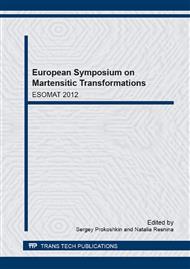p.486
p.491
p.496
p.501
p.506
p.512
p.518
p.525
p.530
Martensitic Transformation in Ni-Al-Pt High Temperature Shape Memory Alloys
Abstract:
In alloys Ni–39(41)Al–xPt (x = 5,10,15,20 at.%) the alloying by Pt strongly increases the Ms point. There is no direct proportionality between the Pt content and the Ms point increasing. No traces of Ni3Al were found in the alloys. The precipitation of Ni5Al3 was observed in Ni–39Al–15Pt alloy after cycling through the temperature range between the room temperature and 800°C. The effect of Pt alloying on the martensitic transformation and high temperature martensitic transformation stability is governed by the competition between the martensitic transformation and formation of the Ni5Al3 phase upon the cooling. Pt addition, instead of Ni, can resolve the problem of decomposition processes because the alloy composition is shifted out of the Ni3Al domain on the phase diagram and it reduces the influence of the Ni5Al3 phase on the degradation of martensitic transformation.
Info:
Periodical:
Pages:
506-511
Citation:
Online since:
January 2013
Price:
Сopyright:
© 2013 Trans Tech Publications Ltd. All Rights Reserved
Share:
Citation:


